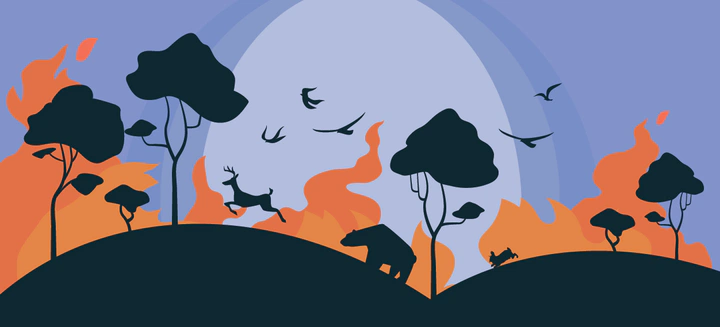Wildfires in Canada

What are the main sources of wildfires in Canada?
Grades 5 - 9
Wildfires have recently become an urgent concern in Canada. They significantly decrease air quality and pose threats to ecosystems, human lives, and the environment. This week, we explore the various causes of wildfires in Canada, identifying the most destructive types. Moreover, we explore why some classes of wildfires are more destructive than others, and propose possible explanations for the higher prevalence of wildfires during specific months of the year.
To answer our question we:
- Utilized datasets from the National Forestry Database (Forest Fires | National Forestry Database) from 1990-2021
- Identified primary causes by comparing hectares of land burnt with the number of wildfires
- Investigated trends in wildfire data, separating data by province and specific years/months
We defined five main causes of wildfires based on the National Forestry Database:
Human Activity: wildfires ignited by human actions, including accidental causes like discarded cigarettes, unattended campfires, sparks from faulty machinery, power line failures, or intentional acts of arson.
Lightning: wildfires ignited by natural electrical discharges. These fires are particularly prevalent in remote or forested areas where lightning strikes are more likely to occur.
Prescribed: wildfires intentionally ignited by fire management authorities for ecological purposes, such as promoting forest health, reducing fuel loads, managing vegetation, or restoring natural fire regimes.
Reburn: wildfires ignited by residual heat or smoldering embers from previous wildfires. Even after a fire has been extinguished, heat can remain trapped within logs, root systems, or organic matter. Under certain conditions, such as dry and windy weather, these residual heat sources can reignite, leading to new fires within previously burned areas.
Unspecified: wildfires ignited by unknown causes. Causes are unspecified either due to a lack of evidence or an incomplete data entry.
Visualizing the data
Using the dataset, we analyzed the leading causes of wildfires and the total land area affected by wildfires ignited by these causes (measured in hectares). Our visualizations indicated that human activity and lightning were the primary causes of wildfires and land destruction. As a result, our visualizations focus exclusively on these two categories.
These graphs illustrate that both human activity and lightning strikes have been the primary causes of wildfires over the years, with neither cause significantly outweighing the other. In specific years, like 1991, human activity caused more wildfires than lightning strikes, while in other years, such as 1998, lightning strikes surpassed human activity as the main cause of wildfires. However, wildfires sparked by lightning strikes seem to be significantly more destructive, scorching larger land areas than those caused by human activities.
Below are several factors contributing to the heightened destructiveness of wildfires caused by lightning.
Location: human-caused fires often occur in populated areas with well-managed vegetation, leading to smaller, localized fires. In contrast, lightning-caused fires can occur in remote and inaccessible areas, where it is easier for them to spread.
Natural Factors: lightning-caused fires tend to ignite in regions with favourable atmospheric conditions for fire spread, such as dry and windy weather.
Human Intervention: human-caused fires often begin in populated areas, prompting immediate responses that help mitigate their spread.
Some questions you might like to explore with these visualizations:
- Are there any other factors that could explain why wildfires from human activity burn less land mass compared to lightning-based wildfires?
- Do the visualizations provide any conclusive evidence on whether the number of wildfires is increasing or decreasing?
Finally, we delved into wildfire data for different provinces to identify the months with the highest frequency of wildfires. We then narrowed our focus to Alberta, exploring historical data to identify the months with the most destructive wildfires.
In Alberta, wildfires begin to surface in April, reach their peak around July, and subside by September. These trends correspond to the region's higher temperatures and decreased precipitation during the spring and summer months. Higher temperatures and decreased precipitation create dry and combustible conditions that are conducive to the ignition and rapid spread of wildfire.
This trend has remained consistent over the years. While certain years like 2002 and 2004, show spikes in June and July, respectively, overall the trend has maintained steady, with gradual fluctuations rather than drastic changes.
Some questions you might like to consider with this visualizations:
- Would you expect other provinces to follow the same trends as Alberta?
- Which provinces do you think are less likely to experience wildfires, and conversely, which provinces are more likely to experience wildfires?
Reflect on what you see
Look and interact with the data visualizations above. When you hover your mouse over the plots, you’ll notice more information appears. You can also use the legend to make plots appear and disappear.
Think about the following questions.
- What do you notice about the visualizations that can lead to meaningful conclusions?
- What do you wonder about the data?
Use the fill-in-the-blank prompts to summarize your thoughts.
- “I used to think _______”
- “Now I think _______”
- “I wish I knew more about _______”
- “These data visualizations remind me of _______”
- "I really like _______”
Learn how we visualized the data
Go to our walk-through (in Jupyter notebook format) to see how the data science process was applied to create these graphs, from formulating a question to gathering the data and analyzing the data with code.